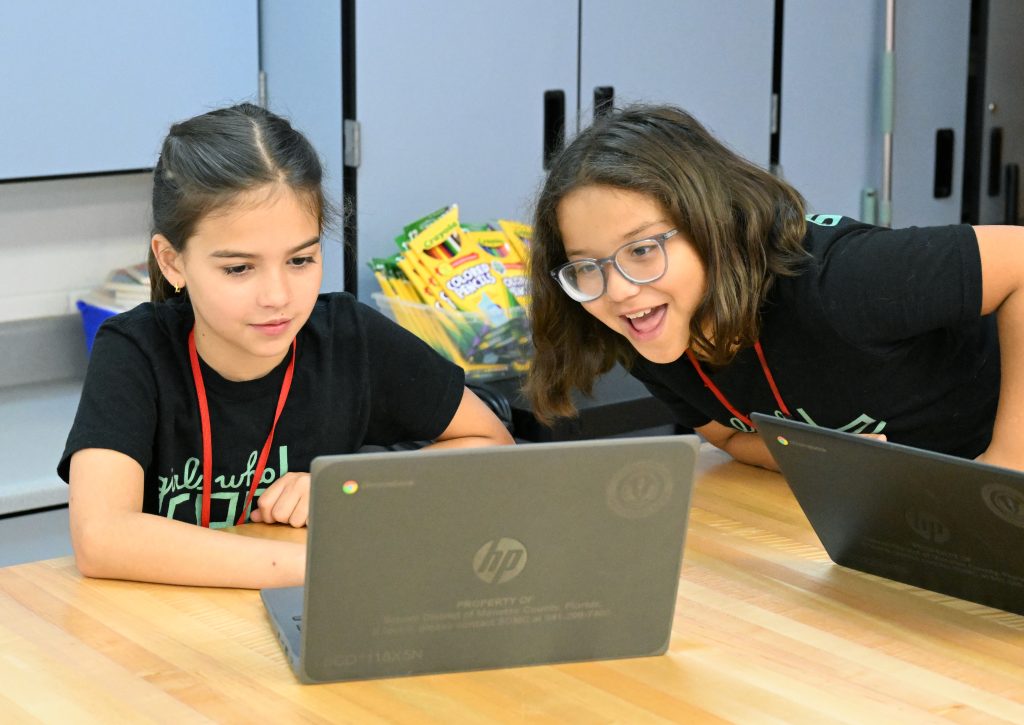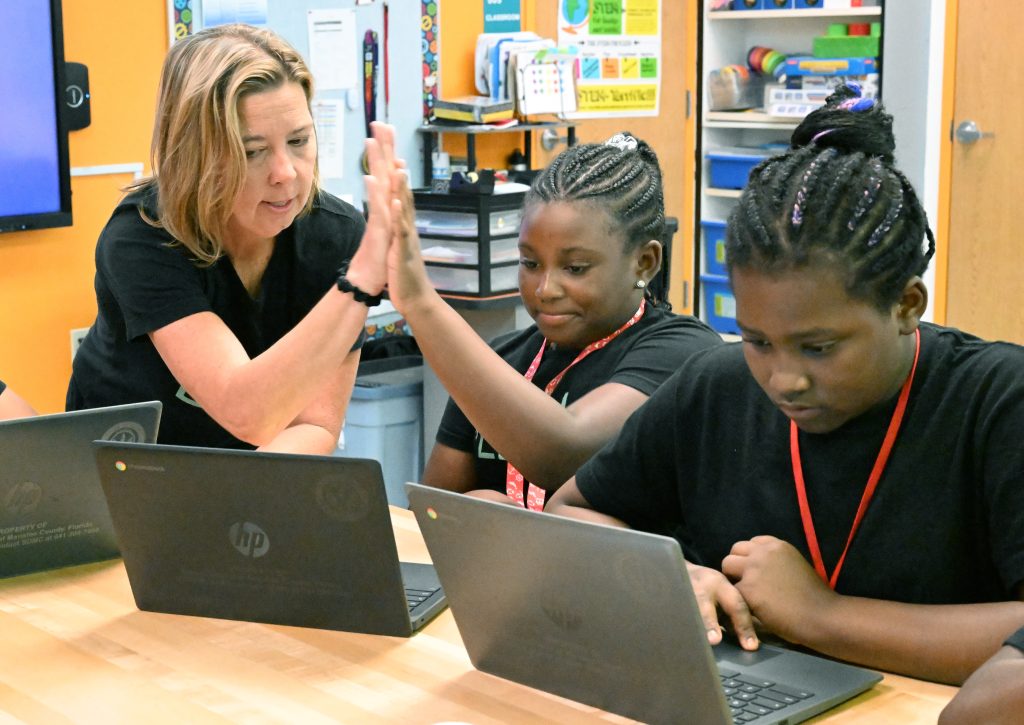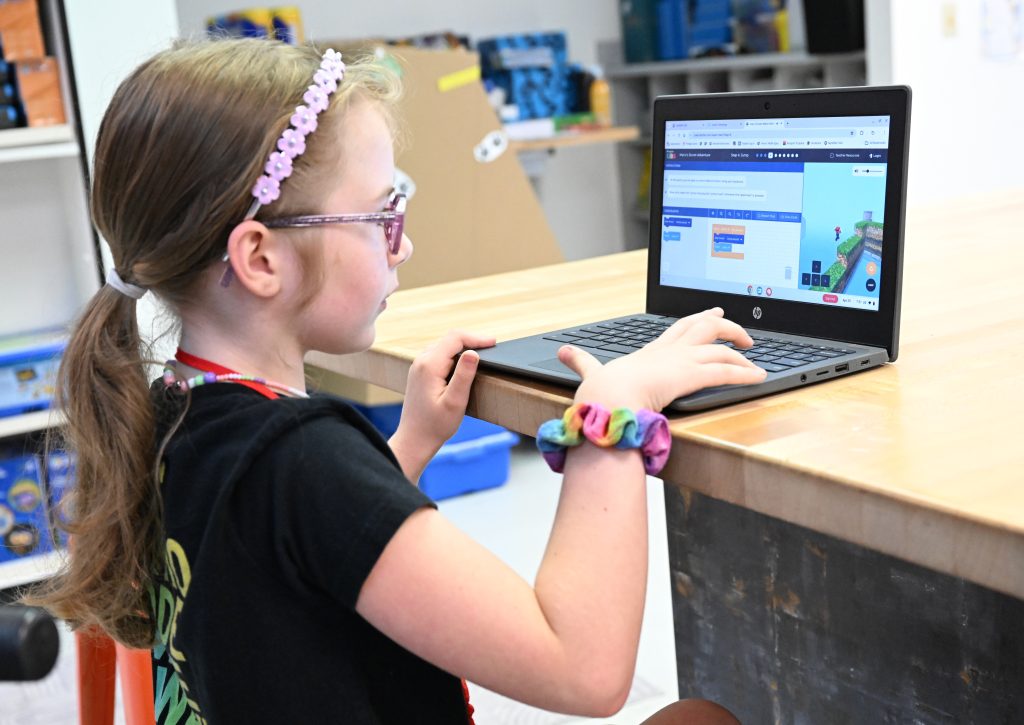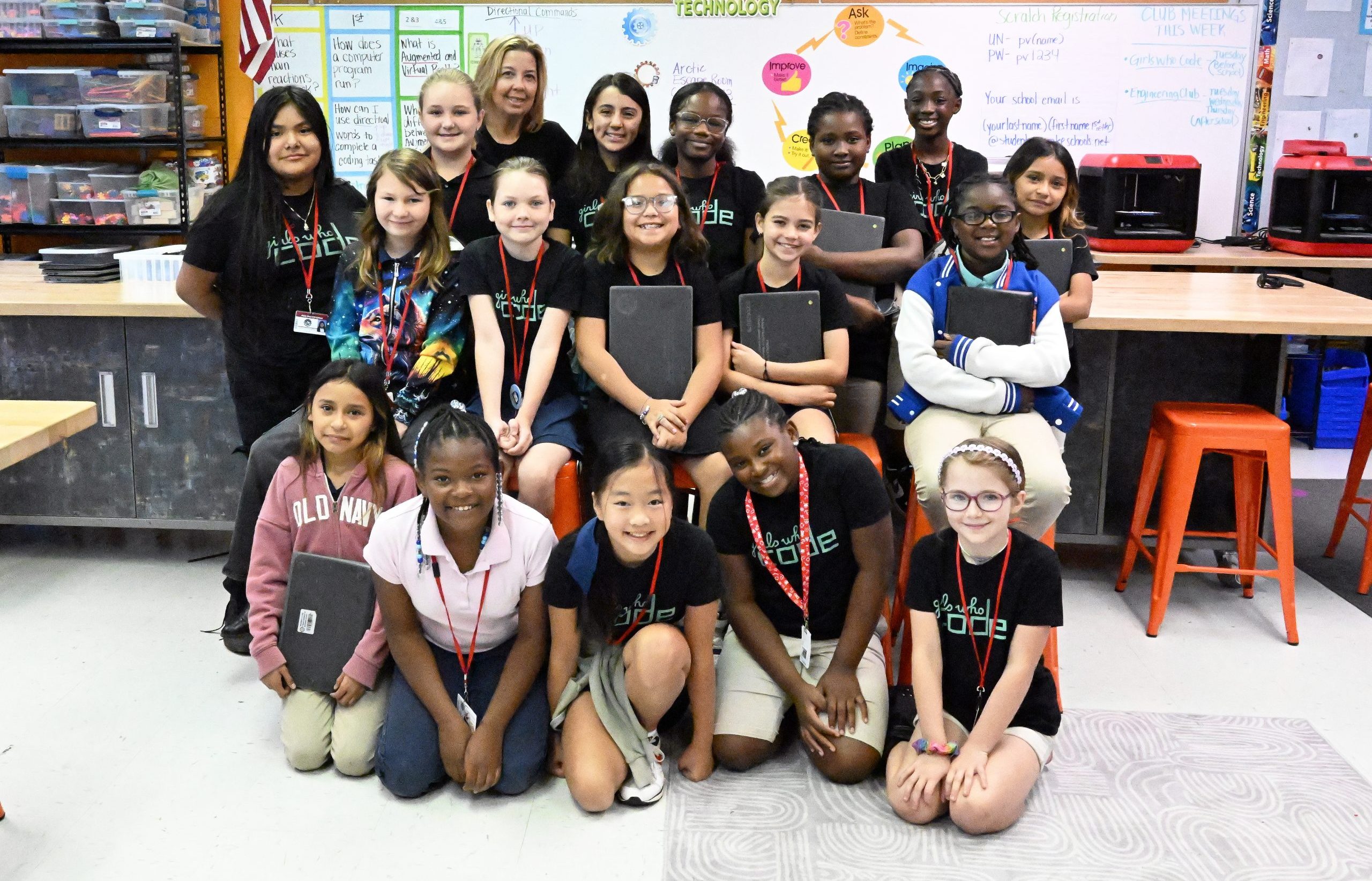WORDS: Shannon Evans
PHOTOS: Wendy Dewhurst
It’s 7:45 a.m. on a Tuesday, and one by one, fourth grade girls trickle into the STEM lab at Palm View K-8. They bring their differences—various backgrounds and personalities, likes and dislikes. But they walk together on common ground, drawn by a growing curiosity about coding.
They’re also all wearing the same shirt, and they’re excited. Because Tuesday mornings at Palm View belong to the Girls Who Code.
Startup Sequence
In 2019, teacher Tarrah Keefe discovered the national nonprofit Girls Who Code, which aims to close the gender gap in tech by equipping girls with the skills and confidence to lead in a digital world. Besides offering college and career programs, the organization helps launch free Girls Who Code clubs in schools, libraries, and afterschool programs for grades 3–12. Ms. Keefe knew instantly that this kind of club would be a perfect fit for Palm View.
“Our school has been working to build strong TSA programs at the middle school level,” she says, “and we’d been trying engaging ways to introduce students to coding—to show them that beyond it simply being educational, it’s fun. I thought starting a Girls Who Code club would be a great way to get more students involved and interested.”
Ms. Keefe has worked at Palm View for 25 years and has taught first, second, and third grades. She always gravitated toward math and science and was excited when the school offered her the STEM teacher position. Although her original training didn’t include coding, she jumped at the chance to learn. Now, she gets to share that knowledge with a unique group of fourth grade girls.
Each week, the girls gather before school starts to work on coding projects. They’re given specific tasks to complete, but Ms. Keefe encourages them to bring their own creativity to the table.
 “I want them to tweak their work in a way that reflects their individual personalities,” Ms. Keefe says. “This reinforces their technical skills but also allows them to express themselves through code. They can customize the colors, add different characters. And as they build in a storyline that shares what they enjoy, each project becomes a reflection of who they are.”
“I want them to tweak their work in a way that reflects their individual personalities,” Ms. Keefe says. “This reinforces their technical skills but also allows them to express themselves through code. They can customize the colors, add different characters. And as they build in a storyline that shares what they enjoy, each project becomes a reflection of who they are.”
For many of the girls, experiencing the coding club sparks a prolonged interest in STEM. Many later apply for Palm View’s 5th grade engineering club, building on the skills and confidence they developed earlier.
In fact, they begin to hone these skills well before fourth grade. Palm View introduces simple coding concepts in kindergarten, like using directional arrows or color-based commands. Even the youngest students can start to understand problem-solving, sequencing, and logic, especially when the concepts are presented in a fun way. As students get older, they build on those basics as they work through the STEM curriculum.
“Every grade participates in some form of coding each year,” Ms. Keefe explains. “But it’s pretty cool to see five-year-olds do it.”
Sisterhood Defined
While the Girls Who Code club is only open to fourth grade girls, the third graders often look forward to joining, seeing it as a special experience they can look forward to. And it’s special for a few different reasons. The girls are learning skills in a field traditionally dominated by men, but they’re also forming a strong sense of belonging. It’s a sisterhood, as Ms. Keefe describes it. And the girls would agree.
“Girls Who Code allows me to work with girls like me,” says fourth grader Bre’Yonne. “It also makes me feel important to be a part of something.”
The girls feel that sense of belonging, but they also proudly show it off with the club shirts, which have become a symbol of their shared identity. Despite the school’s uniform policy, Palm View makes an exception for the girls. “I feel special being able to wear our club shirts to school on meeting days,” club member Madi says.
Another student, Samiyah, loves the social aspect of the club. “It’s helped me make friends with girls who understand me,” she says. While the girls sit with their own computers and build their own projects, they often collaborate. And what better way to get to know someone than through shared experience?
 “They really like helping each other,” Ms. Keefe says. “It doesn’t feel like they’re asking for extra help, it’s just friends working together. Because it’s a smaller setting than a full classroom, they’re not afraid to take risks or ask questions. And teaching each other has helped them understand things better, too. It’s created this great little community where every girl feels like she belongs and is capable.”
“They really like helping each other,” Ms. Keefe says. “It doesn’t feel like they’re asking for extra help, it’s just friends working together. Because it’s a smaller setting than a full classroom, they’re not afraid to take risks or ask questions. And teaching each other has helped them understand things better, too. It’s created this great little community where every girl feels like she belongs and is capable.”
That sense of connection is just as important as the coding itself, and it’s something Ms. Keefe sees developing week after week.
“It’s a safe, empowering space,” she adds. “I love seeing how their confidence has grown—not just in coding, but in how they carry themselves and take on new challenges.”
Parents have noticed the shift, too. “Since joining, Scarlett has gained confidence and feels empowered by the experiences she’s having,” says Amaris Xiong, Scarlett’s mom.
Carla Favorite has seen the same in her daughter, Marina. “Tuesdays are her favorite day because of her club meetings! The program has boosted her confidence, built her interest in technology, and taught her real teamwork. She’s excited to keep going in fifth grade!”
Status: Resilient
If coding club is about learning new skills, another important skill learned here is perseverance. Mistakes happen. Difficulty and confusion crop up. But Ms. Keefe uses these situations as opportunities to teach resilience. We don’t give up; we just try something else is her mantra. Together, the girls can find a way. If mistakes are part of the process, then problem-solving is, too.
Ms. Keefe has watched this important life skill play out time and time again. She remembers one student who joined the club without much confidence in her coding abilities and who wasn’t sure if it was the right fit for her. But the student kept showing up, and that consistency sparked more interest in the program. Eventually, she joined the 5th grade engineering club, and it became obvious that she had an instinctive grasp of how engineering works. Next came the robotics club. Her talent really took off, and she soon became the team’s captain.
“This girl was so committed that she arranged for her family to bring her to school early and pick her up late so she could spend extra time working on our competition projects,” Ms. Keefe says. That student’s ambition didn’t stop in elementary school; she later joined the middle school Technology Student Association (TSA) and has spent the year competing with the team. “Her story is a great example of how determination and the right opportunities can help students grow and keep reaching for more.”
The club itself has come a long way, too, having originally started with seven members. In the 2024-25 school year, it featured 24 girls! As the club moves forward, Ms. Keefe hopes to soon include third graders.
 “Opening it up to younger students could spark their interest in STEM even earlier and help build their confidence from a young age,” she says.
“Opening it up to younger students could spark their interest in STEM even earlier and help build their confidence from a young age,” she says.
When asked what she would say to other educators considering a Girls Who Code club, Ms. Keefe doesn’t hesitate. “As teachers, we’re often stretched thin and constantly trying to make the most of limited time. But setting aside this small amount of time just once a week can make a big impact on a student who is struggling to find their place in the school community.”
And if she could dream up the perfect future project? “I would love for the girls to collaborate on creating a game and then invite their classmates and families to test it,” she says. “This project would give them a chance to apply their coding, design, and problem-solving skills in a fun and meaningful way. Working together on a shared goal would strengthen their teamwork and communication. By opening the game up to classmates and families for testing, the girls could get feedback and make improvements, just like real developers do. It would also be a wonderful opportunity to showcase their hard work and creativity.”
System Activated
What is really going on, then, when a girl writes a line of code—and it works? What does that little spark of success do for her? It starts as a whisper: I can do this. She looks around at the other girls and says, louder, We can do this. She might not see it then, but this Tuesday morning club at her elementary school has become a rehearsal for real life. Here, persistence matters. Teamwork makes all the difference. Mistakes are just part of the journey.
Here, at 7:45 a.m., a new generation of problem-solvers is quietly, confidently finding their voice.
For educators interested in starting a Girls Who Code club at your school, visit www.girlswhocode.com for more information.
Ms. Keefe’s favorite coding joke:
Why do programmers hate nature?
It has too many bugs!





